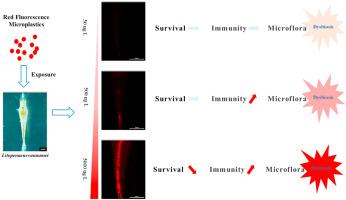Marine Environmental Research ( IF 3.3 ) Pub Date : 2021-05-30 , DOI: 10.1016/j.marenvres.2021.105377 Zhenlu Wang 1 , Lanfen Fan 2 , Jun Wang 2 , Shaolin Xie 2 , Chaonan Zhang 1 , Jiang Zhou 1 , Li Zhang 3 , Guohuan Xu 3 , Jixing Zou 2

|
Microplastics (MPs) are a new type of environmental pollutant. To investigate the response of shrimp and their microflora to MPs, Litopenaeus vannamei (L. vannamei) was exposed to different concentrations of MPs (0, 50, 500, and 5000 μg/L, i.e., C, L, M and H groups) for 48 h. The survival rate, intake of MPs, immune-related gene expression and microbial response under MP exposure were detected. The results showed that the survival rate in the H group was significantly lower than those in the C, L and M groups, while the relative expression levels of proPO, TLR and ALF in the M and H groups were significantly higher than those in the C and L groups. For the microbial response, microbial community richness in the L group was significantly decreased, while community richness and diversity in the H group were significantly increased compared with those in the C group. The relative abundances of 3, 4 and 11 taxa were significantly changed after MP treatment at the phylum, class and genus levels, respectively. The results suggested that short-term exposure to low concentrations of MPs did not cause immune defense responses or death but affected the balance of bacterial composition in shrimp. Exposure to high concentrations of MPs can induce immune responses and microbial changes and can even cause death in shrimp. These findings increase our understanding of MP impacts on aquatic organisms.
中文翻译:

深入了解南美白对虾对微塑料的免疫和微生物反应
微塑料(MPs)是一种新型的环境污染物。为了研究虾及其微生物群对 MP 的反应,将南美白对虾( L. vannamei ) 暴露于不同浓度的 MP(0、50、500 和 5000 μg/L,即 C、L、M 和 H 组) 48 小时。检测MP暴露下的存活率,MP的摄入,免疫相关基因表达和微生物反应。结果显示,H组存活率显着低于C、L、M组,而proPO、TLR、ALF的相对表达水平M组和H组显着高于C组和L组。在微生物反应方面,与C组相比,L组微生物群落丰富度显着降低,而H组微生物群落丰富度和多样性显着增加。MP处理后3、4和11个分类群的相对丰度分别在门、纲和属水平发生了显着变化。结果表明,短期暴露于低浓度 MPs 不会引起免疫防御反应或死亡,但会影响虾体内细菌组成的平衡。暴露于高浓度的 MP 会引起免疫反应和微生物变化,甚至会导致虾死亡。这些发现增加了我们对MP对水生生物影响的理解。



























 京公网安备 11010802027423号
京公网安备 11010802027423号